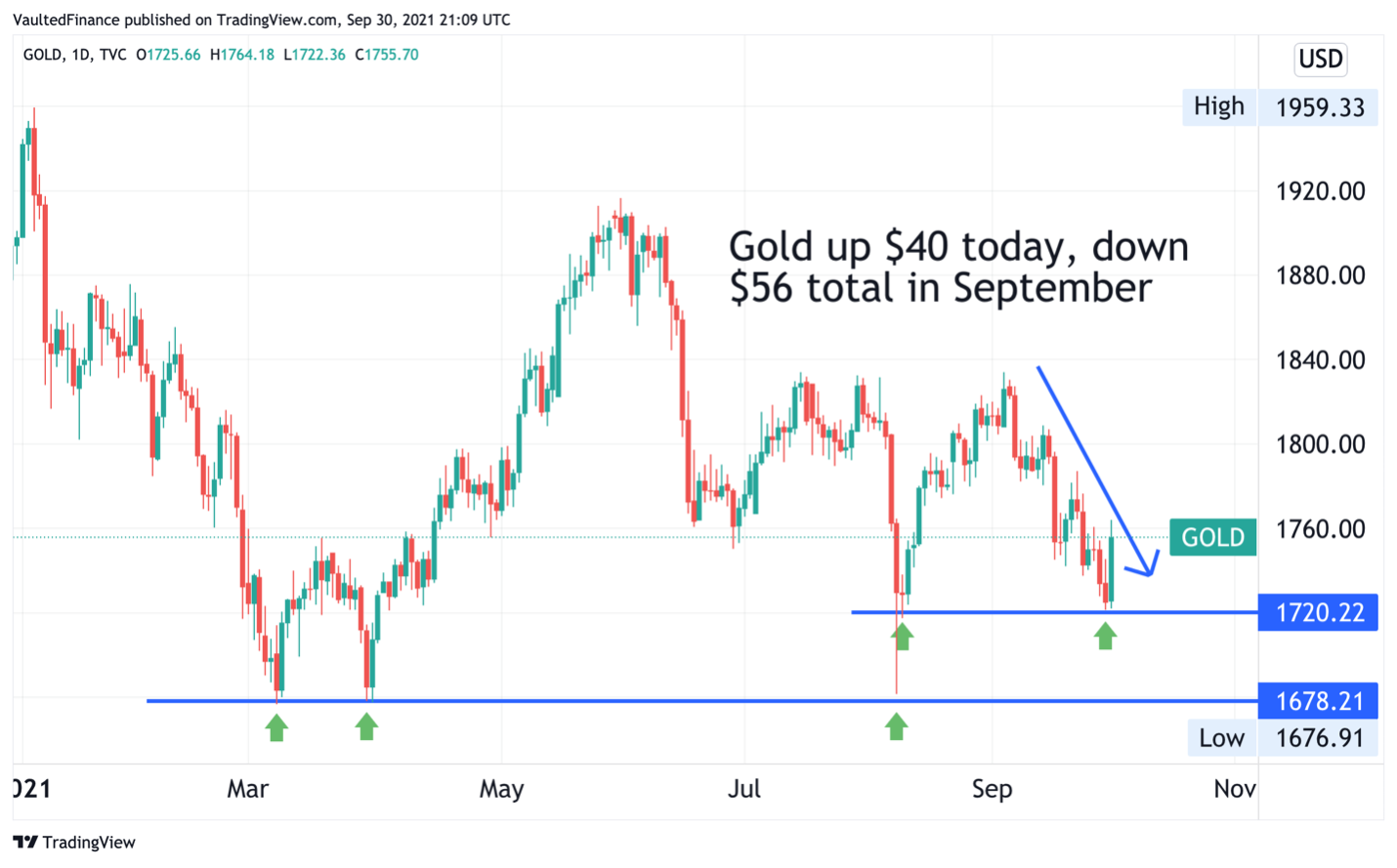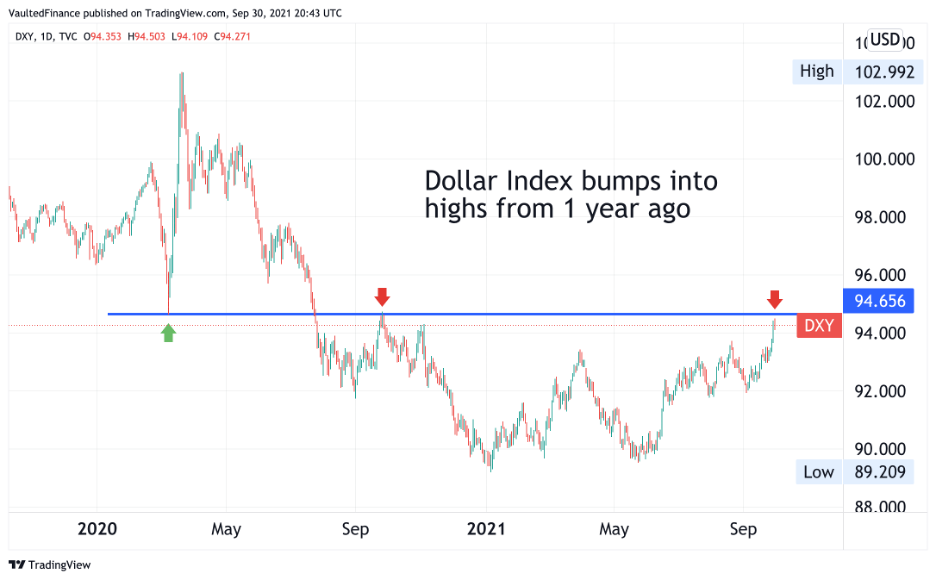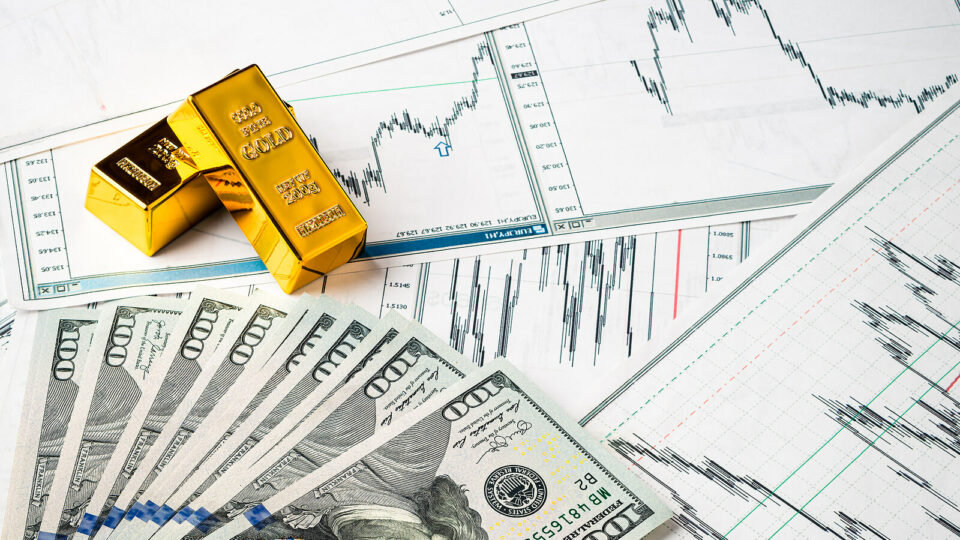The U.S. central bank tries to tame persistent inflation without sacrificing the rampaging and uniquely fragile stock market.
Key Takeaways:
- Options trading volume has reached the highest level in history, as more and more market participants pile in risk in exchange for outsized returns.
- Although the CPI registered a lower reading in August than it did in July, inflationary pressures in housing, shipping, and retail show few signs of slowing down.
- Gold slid down to $1,720/oz this week as the U.S. dollar rallied and bond yields jumped.
Gold still in no man’s land
Gold has dropped below its $1,800 trading range, reacting to the mixed messages coming from the Federal Reserve. Some officials are calling for reduced bond purchases in November and interest rates hikes in 2022. However, Jerome Powell testified before the House Committee today and reiterated his commitment to loose monetary policy, saying the U.S. economy is still “far from full employment.” Gold rose $40 today.

That said, September has been a rough month for the yellow metal. A rising U.S. Dollar Index and higher bond yields are stacking on the pressure. Some analysts expect gold to retest its lows around $1,680.

Despite a big hit on technology stocks and a 3-month decline in consumer confidence, investors have not yet shifted their attention to safe haven assets. Facebook, Google, and Microsoft all tumbled this week. The consumer confidence index, which measures consumer attitudes toward the economy and business conditions, fell in September to 109.3 in September (down from 115.2 in August).
Insatiable desire for risk
One of the most fascinating aspects of the 2021 stock market rally has been the involvement of retail investors. Even more unprecedented, perhaps, is the volume of options trading the markets have seen this year.
Stock options are contracts that give an investor the right to buy or sell a security at a certain price within a period of time. Options can get complex, but everyone should know this: they are extremely risky. This vehicle can multiply gains but can also multiply losses. High risk, high reward.
The new wave of 2021 retail traders have embraced this strategy. On average, more than 38 million option contracts (totaling $432 billion) have been traded EVERY DAY in 2021, setting an all-time record. The average daily volume for stocks is only $404 billion this year. For the first time in history, options trading volume is on track to surpass regular stock trading volume.
What does this mean for the markets?
This options frenzy may explain the parabolic growth in equities this year. When markets are rising, options make them skyrocket. As the Wall Street Journal describes it: “When individual investors buy call options, the Wall Street firms that sell options often hedge their positions by buying the shares, further contributing to rising markets.”
Unfortunately, they have the same intensifying effect when markets are going down. Options create volatility.
Retail investors, armed with the power of leverage and Fed stimulus, have completely changed the stock market landscape. No one knows how it will end, but this insatiable desire for risk perfectly represents the “greed” side of the most important dichotomy in all of investing: greed and fear.
Is inflation slowing down?
In both June and July of this year, the CPI reported a 5.4% increase in prices year-over-year. In August, that number dropped slightly to 5.3%. This prompted many headlines claiming that inflation has peaked, but several factors indicate otherwise.
The Case-Shiller National Home Price Index measures the prices of homes in U.S. metropolitan areas. The index showed that housing prices increased 19.7% from July 2020 to July 2021, the highest growth rate the index has ever recorded. Buyers are competing for an ever-tightening supply. Too many dollars chasing too few homes.
Housing isn’t the only source of inflation. Many companies are still jacking up prices to cover rising costs of labor and materials. Shipping delays in major ports are straining supply chains all over the nation. It goes like this:
- Businesses order lots of goods and materials to replenish supplies post-COVID
- Shipping ports (such as those in Los Angeles and Long Beach, CA) cannot find employees
- Dozens of ships line up for weeks on end, waiting for their turn to dump their cargo, where it will be stacked on top of other shipping containers
- Freight trains and trucking companies are also struggling to find labor, leading to bottlenecks and inefficiencies throughout the entire system
- Goods become scarce; businesses raise prices.
Stuck between a rock and a hard place
So, the Fed has a problem. Inflation refuses to retreat toward their 2% target, looking less and less “transitory” every month. They cannot fix problems in global supply chains, so they are left with one option: tighten monetary policy.
The Fed is currently buying $120 billion of treasury bonds monthly. To put this in perspective, the Fed is creating $364 for every single person in the United States every month. However, tapering these asset purchases is easier said than done.
When the Fed started reducing asset purchases in 2013, investors reacted with the famous “taper tantrum,” spiking treasury yields and destabilizing equities markets. Higher interest rates threaten the stock market because the stock market thrives on cheap money (especially in 2021).
Additionally, if treasury yields spike, governments will be forced to pay higher interest rates on their debt, eating up a huge chunk of government tax revenue. The U.S. government is already projected to spend more than 10% of federal revenue on interest payments this year, and that is with rock-bottom yields.
Total U.S. federal debt held by the public has reached $28.53 trillion. That, right there, is the fundamental reason to own some assets that are not denominated in fiat currency. Central banks are in a tough position to be sure. Maybe that is why they are stacking gold in their vaults.
Secure gold savings, without the excessive fees
Your weekly gold market commentary comes from our internal team of researchers and technical experts. Vaulted gives modern investors access to physical gold ownership at the best cost structure in the industry. With personal advising from industry experts and access to premier precious metals strategies, Vaulted is the key to life-long financial prosperity. Start protecting your portfolio today.
As always, thank you so much for reading – and happy investing!











